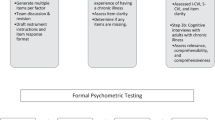Abstract
Although materials informing parents about children’s mental health (CMH) problems can improve outcomes, we know relatively little about the design factors that might influence their utilization of available resources. We used a discrete choice conjoint experiment to model the information preferences of parents seeking mental health services for 6 to 18 year olds. Parents completed 30 choice tasks presenting experimentally varied combinations of 20 four-level CMH information content, transfer process, and outcome attributes. Latent class analysis revealed three segments with different preferences. Parents in the Action segment (43%) chose materials providing step-by-step solutions to behavioral or emotional problems. They preferred weekly meetings with other parents and coaching calls from a therapist. The Information segment (41%) chose materials helping them understand rather than solve their child’s problems. These parents were more sensitive to logistical factors such as receiving information in groups, the location where information was available, the modality in which the information was presented, and the time required to obtain and use the information. The Overwhelmed segment (16%) reported more oppositional and conduct problems, felt their children’s difficulties exerted a greater adverse impact on family functioning, and reported higher personal depression scores than those in the Action or Information segments. Nonetheless, they did not choose information about, or solutions to, the problems their children presented. Simulations predicted that maximizing utilization and realizing the potential benefits of CMH information would require knowledge transfer strategies consistent with each segment’s preferences.

Similar content being viewed by others
Notes
Briefly, CBC/HB uses Bayes theorem and simulated Monte Carlo Markov Chain processes (e.g. Gibbs Sampling) to estimate partworths or conjoint utilities for each participant. This program is referred to as hierarchical Bayes because the estimation process samples from two distributions of scores: (1) an upper level model which estimates part-worth utility averages and variances for the sample population, and (2) a lower level model drawing on the choices of each respondent in the study sample (Orme 2006).
Randomized First Choice Simulations improve prediction by estimating both attribute variability and product variability (Huber et al. 2007). We computed 100,000 sampling iterations to stabilize estimates.
References
Ahmed, S. F., Blamires, C., & Smith, W. (2007). Facilitating and understanding the family’s choice of injection device for growth hormone therapy by using conjoint analysis. Archives of Disease in Childhood, DOI 10.1136/adc.2006.105353.
Ajzen, I. (1991). The theory of planned behavior. Organizational Behavior and Human Decision Processes, 50(2), 179–211.
Allenby, G. M., Arora, N., & Gintner, J. L. (1995). Incorporating prior knowledge into the analysis of conjoint studies. Journal of Marketing Research, 32, 152–162.
Allenby, G. M., Fennell, G., Huber, J., Eagle, T., Gilbride, T., Horsky, D., et al. (2005). Adjusting choice models to better predict market behavior. Marketing Letters, 16(3–4), 197–208.
Andrews, J. N., Swank, P. R., Foorman, B., & Fletcher, J. M. (1995). Effects of educating parents about ADHD. The ADHD Report, 3, 12–13.
Armitage, C. J., & Conner, M. (2001). Efficacy of the theory of planned behaviour: a meta-analytic review. The British Journal of Social Psychology, 40(4), 471–499.
Arora, N., Allenby, G. M., & Ginter, J. L. (1998). A hierarchical Bayes model of primary and secondary demand. Marketing Science, 17(1), 29–44.
Arora, N., & McHorney, C. A. (2000). Patient preferences for medical decision making: who really wants to participate. Medical Care, 38(3), 335–341.
Beevers, C. G. (2005). Cognitive vulnerability to depression: a dual process model. Clinical Psychology Review, 25(7), 975–1002.
Bowskill, R., Clatworthy, J., Parham, R., Rank, T., & Horne, R. (2007). Patients’ perceptions of information received about medication prescribed for bipolar disorder: implications for informed choice. Journal of Affective Disorders, 100(1–3), 253–257.
Boyle, M. H., Offord, D. R., Racine, Y., Fleming, J. E., Szatmari, P., & Sanford, M. (1993). Evaluation of the revised Ontario Child Health Study scales. Journal of Child Psychology and Psychiatry, 34(2), 189–213.
Chi, T. C., & Hinshaw, S. P. (2002). Mother–child relationships of children with ADHD: the role of maternal depressive symptoms and depression-related distortions. Journal of Abnormal Child Psychology, 30(4), 387(14).
Corkum, P., Rimer, P., & Schachar, R. (1999). Parental knowledge of attention-deficit hyperactivity disorder and opinions of treatment options: impact on enrollment and adherence to a 12-month treatment trial. Canadian Journal of Psychiatry, 44(10), 1043–1048.
Coulter, A., Entwistle, V., & Gilbert, D. (1999). Sharing decisions with patients: is the information good enough. British Medical Journal, 318(7179), 318–322.
Crossley, J., & Davies, H. (2005). Doctors’ consultations with children and their parents: a model of competencies, outcomes and confounding influences. Medical Education, 39(8), 807–819.
Cunningham, C. E. (2007). A family-centered approach to planning and measuring the outcome of interventions for children with attention-deficit/hyperactivity disorder. Journal of Pediatric Psychology, 32(6), 676–694.
Cunningham, C. E., Boyle, M., Offord, D., Racine, Y., Hundert, J., Secord, M., et al. (2000). Tri-ministry study: correlates of school-based parenting course utilization. Journal of Consulting and Clinical Psychology, 68(5), 928–933.
Cunningham, C. E., Buchanan, D., & Deal, K. (2004). Modelling patient-centred children’s health services using choice-based conjoint hierarchical Bayes (pp. 249–256). 10th Annual Sawtooth Software Conference Proceedings, San Antonio, TX.
Cunningham, C. E., Deal, K., Neville, A., Rimas, H., & Lohfeld, L. (2006). Modeling the problem-based learning preferences of McMaster University undergraduate medical students using a discrete choice conjoint experiment. Advances in Health Sciences Education: Theory and Practice, 11(3), 245–266.
Cunningham, C. E., Pettingill, P. & Boyle, M. H. (2007). The brief child and family phone interview version 3: Interviewer’s manual. Retrieved April 3, 2008, from http://bcfpi.com.libaccess.lib.mcmaster.ca/bcfpi/downloads.html.
Desarbo, W. S., Ramaswamy, V., & Cohen, S. H. (1995). Market segmentation with choice-based conjoint analysis. Marketing Letters, 6(2), 137–147.
Dwight-Johnson, M., Lagomasino, I. T., Aisenberg, E., & Hay, J. (2004). Using conjoint analysis to assess depression treatment preferences among low-income Latinos. Psychiatric Services, 55(8), 934–936.
Dwight-Johnson, M., Sherbourne, C. D., Liao, D., & Wells, K. B. (2000). Treatment preferences among depressed primary care patients. Journal of General Internal Medicine, 15(8), 527–534.
Elgar, F. J., Mills, R. S. L., McGrath, P. J., Waschbusch, D. A., & Brownridge, D. A. (2007). Maternal and paternal depressive symptoms and child maladjustment: the mediating role of parental behavior. Journal of Abnormal Child Psychology, 35(6), 943–955.
Fraenkel, L., Gulanski, B., & Wittink, D. (2006). Patient treatment preferences for osteoporosis. Arthritis and Rheumatism, 55(5), 729–735.
Garland, A. F., Lewczyk-Boxmeyer, C. M., Gabayan, E. N., & Hawley, K. M. (2004). Multiple stakeholder agreement on desired outcomes for adolescents’ mental health services. Psychiatric Services, 55(6), 671–676.
Godolphin, W., Towle, A., & McKendry, R. (2001). Evaluation of the quality of patient information to support informed shared decision-making. Health Expectations, 4(4), 235–242.
Gold, M., Cunningham, C. E., Deal, K., & & Rimas, H. (2008). Bringing children’s mental health research home: a qualitative analysis of the information preferences of parents of children with mental health problems. Unpublished manuscript.
Gotlib, I. H., Kasch, K. L., Traill, S., Joormann, J., Arnow, B. A., & Johnson, S. L. (2004a). Coherence and specificity of information-processing biases in depression and social phobia. Journal of Abnormal Psychology, 113(3), 386–398.
Gotlib, I. H., Krasnoperova, E., Yue, D. N., & Joormann, J. (2004b). Attentional biases for negative interpersonal stimuli in clinical depression. Journal of Abnormal Psychology, 113(1), 121–135.
Gotlib, I. H., & Meltzer, S. J. (1987). Depression and the perception of social skill in dyadic interaction. Cognitive Therapy and Research, 11(1), 41–53.
Hoagwood, K. E. (2005). Family-based services in children’s mental health: a research review and synthesis. Journal of Child Psychology and Psychiatry, 46(7), 690–713.
House of Commons Health Committee. (2003). Patient and public involvement in the NHS. London England: The Stationary Office Limited. from http://www.parliament.the-stationery-office.co.uk/pa/cm200203/cmselect/cmhealth/697/697.pdf.
Huber, J., Orme, B., & Miller, R. (2007). Dealing with product similarity in conjoint simulations. In A. Gustafsson, A. Herrmann, & F. Huber (Eds.), Conjoint Measurement: Methods and Applications (4th ed., pp. 347–362). New York: Springer.
Johnston, C., Seipp, C., Hommersen, P., Hoza, B., & Fine, S. (2005). Treatment choices and experiences in attention deficit and hyperactivity disorder: relations to parents’ beliefs and attributions. Child: Care, Health and Development, 31(6), 669–677.
Kazdin, A. E., & Wassell, G. (1999). Barriers to treatment participation and therapeutic change among children referred for conduct disorder. Journal of Clinical Child Psychology, 28(2), 160–172.
Kerr, N., Scott, J., & Phillips, M. L. (2005). Patterns of attentional deficits and emotional bias in bipolar and major depressive disorder. The British Journal of Clinical Psychology, 44(3), 343–356.
Lenk, P. J., DeSarbo, W. S., Green, P. E., & Young, M. R. (1996). Hierarchical Bayes conjoint analysis: recovery of partworth heterogeneity from reduced experimental designs. Marketing Science, 15(2), 173–192.
Lissman, T. L., & Boehnlein, J. K. (2001). A critical review of internet information about depression. Psychiatric Services, 52(8), 1046–1050.
Louviere, J., Hensher, D., & Swait, J. (2007). Conjoint preference elicitation methods in the broader context of random utility theory preference elicitation methods. In A. Gustafsson, A. Herrmann, & F. Huber (Eds.), Conjoint measurement—methods and applications (4th Ed., pp. 167–197). New York: Springer.
Luce, R. D., & Tukey, J. W. (1964). Simultaneous conjoint measurement: a new type of fundamental measurement. Journal of Mathematical Psychology, 1(1), 1–27.
MacNaughton, K. L., & Rodrigue, J. R. (2001). Predicting adherence to recommendations by parents of clinic-referred children. Journal of Consulting and Clinical Psychology, 69(2), 262–270.
Maughan, A., Cicchetti, D., Toth, S. L., & Rogosch, F. A. (2007). Early-occurring maternal depression and maternal negativity in predicting young Children’s emotion regulation and socioemotional difficulties. Journal of Abnormal Child Psychology, 35(5), 685–703.
McGregor, J. C., Harris, A. D., Furuno, J. P., Bradham, D. D., & Perencevich, E. N. (2007). Relative influence of antibiotic therapy attributes on physician choice in treating acute uncomplicated pyelonephritis. Medical Decision Making, 27(4), 387–394.
Montgomery, P., Bjornstad, G., & Dennis, J. (2006). Media-based behavioural treatments for behavioural problems in children. Cochrane Database of Systematic Reviews (Online), 1(1), CD002206.
O’Connor, A. M., Bennett, C., Stacey, D., Barry, M. J., Col, N. F., Eden, K. B., et al. (2007). Do patient decision aids meet effectiveness criteria of the international patient decision aid standards collaboration? A systematic review and meta-analysis. Medical Decision Making, 27(5), 554–574.
O’Connor, A. M., Stacey, D., Rovner, D., Holmes-Rovner, M., Tetroe, J., Llewellyn-Thomas, H., et al. (2001). Decision aids for people facing health treatment or screening decisions. Cochrane Database of Systematic Reviews, (3)(3), CD001431.
Orme, B. K. (2006). Getting started with conjoint analysis: strategies for product design and pricing research. Madison: Research.
Oudhoff, J. P., Timmermans, D. R., Knol, D. L., Bijnen, A. B., & Van der Wal, G. (2007). Prioritising patients on surgical waiting lists: a conjoint analysis study on the priority judgments of patients, surgeons, occupational physicians, and general practitioners. Social Science & Medicine, 64(9), 1863–1875.
Owens, P. L., Hoagwood, K., Horwitz, S. M., Leaf, P. J., Poduska, J. M., Kellam, S. G., et al. (2002). Barriers to children’s mental health services. Journal of the American Academy of Child and Adolescent Psychiatry, 41(6), 731–738.
Patterson, M., & Chrzan, K. (2004). Partial profile discrete choice: what’s the optimal number of attributes? (pp. 173–185). 2003 Sawtooth Software Conference Proceedings, San Antonio, TX.
Payne, J. W., Bettman, J. R., & Johnson, E. J. (1993). The use of multiple strategies in judgment and choice. Hillsdale: Lawrence Erlbaum.
Phillips, K. A., Johnson, F. R., & Maddala, T. (2002). Measuring what people value: a comparison of “attitude” and “preference” surveys. Health Services Research, 37(6), 1659–1679.
President’s New Freedom Commission on Mental Health. (2003). Achieving the promise: Transforming mental health care in America (Final Report No. SMA 03-3832) from http://www.mentalhealthcommission.gov.libaccess.lib.mcmaster.ca/reports/FinalReport/toc.html.
Rinck, M., & Becker, E. S. (2005). A comparison of attentional biases and memory biases in women with social phobia and major depression. Journal of Abnormal Psychology, 114(1), 62–74.
Ruland, C. M. (1999). Decision support for patient preference-based care planning: effects on nursing care and patient outcomes. Journal of the American Medical Informatics Association, 6(4), 304–312.
Ryan, M. (1999). Using conjoint analysis to take account of patient preferences and go beyond health outcomes: an application to in vitro fertilisation. Social Science & Medicine, 48(4), 535–546.
Ryan, M., & Farrar, S. (2000). Using conjoint analysis to elicit preferences for health care. British Medical Journal, 320(7248), 1530–1533.
Ryan, M., & Gerard, K. (2003). Using discrete choice experiments to value health care programmes: current practice and future research reflections. Applied Health Economics and Health Policy, 2(1), 55–64.
Sawtooth Software Inc. (2004a). The CBC latent class technical paper (version 3)., 1–20. Retrieved November 16, 2007, from http://www.sawtoothsoftware.com.libaccess.lib.mcmaster.ca/education/techpap.html.
Sawtooth Software Inc. (2004b). The CBC/HB system for hierarchical Bayes estimation version 4.0 technical paper. Sawtooth Software Technical Paper Series, 1–31. http://www.sawtoothsoftware.com.libaccess.lib.mcmaster.ca/download/techpap/hbtech.pdf.
Schor, E. L., & American Academy of Pediatrics Task Force on the Family (2003). Family pediatrics: report of the task force on the family. Pediatrics, 111(6), 1541–1571.
Segrin, C. (2000). Social skills deficits associated with depression. Clinical Psychology Review, 20(3), 379–403.
Sherbourne, C. D., Sturm, R., & Wells, K. B. (1999). What outcomes matter to patients. Journal of General Internal Medicine, 14(6), 357–363.
Singh, J., Cuttler, L., Shin, M., Silvers, J. B., & Neuhauser, D. (1998). Medical decision-making and the patient: understanding preference patterns for growth hormone therapy using conjoint analysis. Medical Care, 36(8 Suppl), AS31–AS45.
Spoth, R., & Redmond, C. (1993). Identifying program preferences through conjoint analysis: illustrative results from a parent sample. American Journal of Health Promotion, 8(2), 124–133.
Stanek, E. J., Oates, M. B., McGhan, W. F., Denofrio, D., & Loh, E. (2000). Preferences for treatment outcomes in patients with heart failure: symptoms versus survival. Journal of Cardiac Failure, 6(3), 225–232.
Vick, S., & Scott, A. (1998). Agency in health care. examining patients’ preferences for attributes of the doctor–patient relationship. Journal of Health Economics, 17(5), 587–605.
Vriens, M., Wedel, M., & Wilms, T. (1996). Metric conjoint segmentation methods: a Monte Carlo comparison. Journal of Marketing Research, 33(1), 73–85.
Wills, C. E., & Holmes-Rovner, M. (2006). Integrating decision making and mental health interventions research: research directions. Clinical Psychology, 13(1), 9–25.
Author information
Authors and Affiliations
Corresponding author
Additional information
Dr. Cunningham is Professor, Department of Psychiatry and Behavioural Neurosciences and the Jack Laidlaw Chair in Patient-Centred Health Care. Dr. Deal is Associate Professor of Strategic Market Leadership and Health Services Management, DeGroote School of Business. Heather Rimas is the Research Coordinator of the Patient-Centred Service Research Unit. Michelle Gold is now at the Canadian Mental Health Association, Ontario Division. This project was supported by a grant from the Canadian Institute of Health Research and the Jack Laidlaw Chair in Patient-Centred Health at McMaster University Faculty of Health Sciences. Dr. Boyle is Professor, Department of Psychiatry and Behavioral Neuroscience, Michelle Gold is now at the Canadian Mental Health Foundation, Toronto, Ontario. We acknowledge the assistance of Contact Hamilton, Peel Children’s Services, Kinark Child and Family Services, and the Child Parent Resource Institute.
Rights and permissions
About this article
Cite this article
Cunningham, C.E., Deal, K., Rimas, H. et al. Modeling the Information Preferences of Parents of Children with Mental Health Problems: A Discrete Choice Conjoint Experiment. J Abnorm Child Psychol 36, 1123–1138 (2008). https://doi.org/10.1007/s10802-008-9238-4
Received:
Accepted:
Published:
Issue Date:
DOI: https://doi.org/10.1007/s10802-008-9238-4




